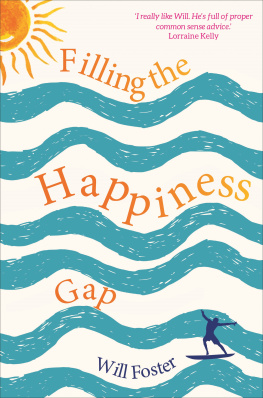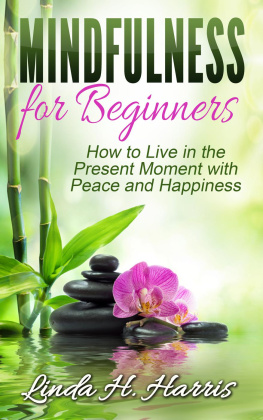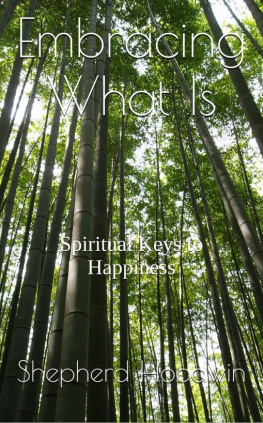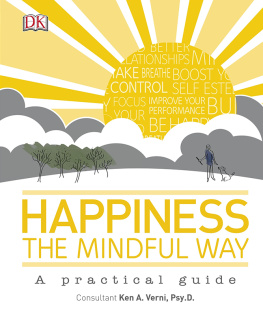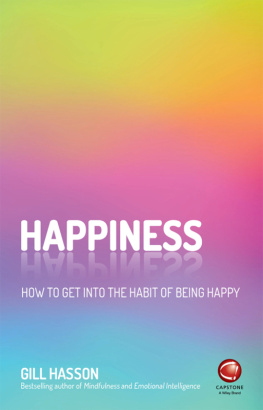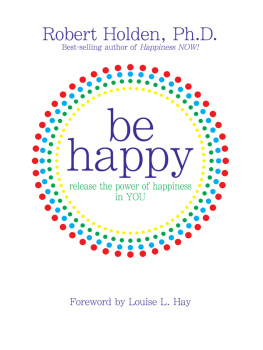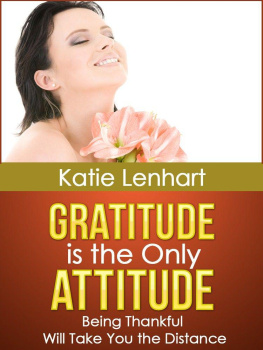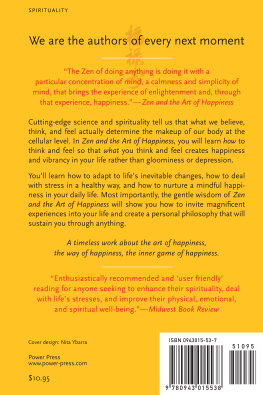
First published and distributed in the United Kingdom by:
Hay House UK Ltd, Astley House, 33 Notting Hill Gate, London W11 3JQ
Tel: +44 (0)20 3675 2450; Fax: +44 (0)20 3675 2451; www.hayhouse.co.uk
Published and distributed in the United States of America by:
Hay House Inc., PO Box 5100, Carlsbad, CA 92018-5100
Tel: (1) 760 431 7695 or (800) 654 5126; Fax: (1) 760 431 6948 or (800) 650 5115 www.hayhouse.com
Published and distributed in Australia by:
Hay House Australia Ltd, 18/36 Ralph St, Alexandria NSW 2015
Tel: (61) 2 9669 4299; Fax: (61) 2 9669 4144; www.hayhouse.com.au
Published and distributed in India by:
Hay House Publishers India, Muskaan Complex, Plot No.3, B-2, Vasant Kunj, New Delhi 110 070
Tel: (91) 11 4176 1620; Fax: (91) 11 4176 1630; www.hayhouse.co.in
Distributed in Canada by:
Raincoast Books, 2440 Viking Way, Richmond, B.C. V6V 1N2
Tel: (1) 604 448 7100; Fax: (1) 604 270 7161; www.raincoast.com
Text Will Foster, 2017
The moral rights of the author have been asserted.
All rights reserved. No part of this book may be reproduced by any mechanical, photographic or electronic process, or in the form of a phonographic recording; nor may it be stored in a retrieval system, transmitted or otherwise be copied for public or private use, other than for fair use as brief quotations embodied in articles and reviews, without prior written permission of the publisher.
The information given in this book should not be treated as a substitute for professional medical advice; always consult a medical practitioner. Any use of information in this book is at the readers discretion and risk. Neither the author nor the publisher can be held responsible for any loss, claim or damage arising out of the use, or misuse, of the suggestions made, the failure to take medical advice or for any material on third party websites.
A catalogue record for this book is available from the British Library.
ISBN 978-1-78180-944-0 in print
ISBN 978-1-78180-976-1 in ePub format
ISBN 978-1-78817-086-4 in Kindle formats
Interior illustrations: Shutterstock
This book is dedicated to Alice and Daisy.
You guys rock my world!
Contents


When I went to school, they asked me what I
wanted to be when I grew up. I wrote down happy.
They told me I didnt understand the assignment
and I told them they didnt understand life.
JOHN LENNON
Have you ever said (out loud or in your mind): Once I have x in my life or y out of my life, then Ill be happy? If your answer is maybe or yes, youve come to the right place. This book is designed to fill your spirit with enough of the good stuff to reframe Ill be happy when I have to Im happier with now, and excited about whats to come.
Becoming happier, not happy
A few years ago, as part of a self-prescribed experiment, I started doing gratitude, acceptance and meditation exercises to see if they could help increase my happiness. I noticed very little change at first. Life was still life: full of ups and downs, stresses and strains. As the motivational coach Brendon Burchard pointed out in a YouTube video I was watching one Tuesday evening after admitting I needed a boost after a tough day common knowledge doesnt equate to common practice.
At work, the energy-sapping guy still managed to corner me (despite my innumerable attempts to hide from him in the cleaning cupboard); I still found it aggravating when my train was overdue; and although I was more mindful about trying to remain in control of my emotions, my worries about money, health and relationships were still very real and there.
I asked some of my life-coaching and personal-training clients to try my gratitude, acceptance and being present practices too, and their experience was similar to mine. I dont feel all that different, Will, said one. But for reasons I cant describe, Im happier. It feels like something I cant explain in words.
And thats what I passionately want people to shoot for in their emotional wellbeing. As Harvard professor and happiness researcher Tal Ben-Shahar says, we should aim for becoming happier in life, but not necessarily happy.
Rather than making happy the goal, I prefer folks
try for What can I do to become a bit happier?
In fact, the word happy leaves a weird taste in my mouth that stems from the cherry-on-topness of what happiness really means in our day-to-day lives. No one can be happy all the time, and I believe thats one of the reasons why self-help gurus get a bad rap from non-self-helpies (those who feel theyre far too well developed to need self-help, but invariably leave workshops de-scepticized after realizing how much help we all really do need).
You see, happy is an emotion that can come and go as quickly as a fart in a stiff breeze. Someone could feel happy after a workout at the gym, only to come home, have a row with his or her spouse and feel angry all within the space of an hour. Take said man or woman in this upset state and add some social media-induced no one should ever be sad perfectionism, and we have a recipe for double punishment: a) feel bad, and b) feel bad for feeling bad (as guilt, shame, anger, embarrassment or withdrawal kick in that we have a less than blissful existence).
Aiming for happy is like aiming for being confident or contented words we use to describe a finished product, a final destination, a black-and-white box that, as far as my research and experience have shown, exists only at the fingertips of Hollywood scriptwriters or the perfectionist culture of social media, which displays the trailer to the movie and rarely the full show.
Uncovering the Happiness GAP
Over the last decade, Ive researched the work of hundreds of happiness experts from ancient Greek philosophers to modern-day positive psychologists and conducted almost 10,000 hours of one-on-one life coaching, Neuro-Linguistic Programming (NLP) therapy and personal training sessions with CEOs, mums, athletes and everyone in between. What I discovered is that focusing on the cool stuff in your life, accepting what you cant (and can) control, and becoming more mindful of the present leaves us all feeling a whole lot happier.
The 21-day GAP programme I created, and launched on my website, was the brainchild of a) all those years of happiness research, b) personal experience, and c) lots of coffee on a rainy autumnal morning spent pondering a way of melting gratitude, acceptance and living in the now into one happiness-boosting pot. What happened next wasnt something I was expecting.
Online, people responded to the GAP programme in a way Id not seen before. Comments and likes came pouring through. However, rather than let my thirsty ego run wild with the idea that Id done something special (other than put an acronym together), I simply declared that Id get to work on developing the GAP into the most user-friendly happiness-boosting programme possible and thats what youll find in this book.
Once I started testing the GAP programme on my clients, the results were profound. Many remarked on how much calmer and happier they felt after completing it. Towards the end of her 21 days, Joanne wrote, Im happier because I now realize what was making me unhappy before. Her words blew me away, and they sum up why I urge you to give
Next page
